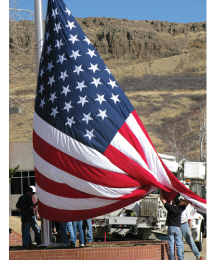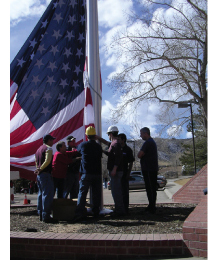
|
|||

|
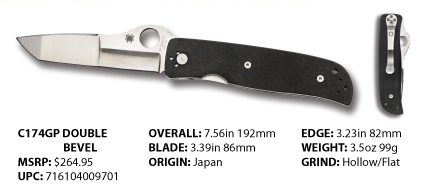
Spyderco’s newest tactical folding knife, the Double Bevel, draws its name from its most distinguishing characteristic—its unique double-ground blade. Near the handle it is hollow ground and has a full-thickness spine for maximum strength, making this section ideal for demanding cutting chores. Near the tip the blade is full-flat-ground for superior edge geometry and low-friction cutting performance. The flat-ground section also features a distal taper that terminates in an Americanized tanto-style point for an exceptional balance of tip strength and sharpness. Like all Spyderco folders, the Double Bevel’s VG-10 stainless steel blade features our Trademark Round Hole™ for ambidextrous one-handed opening. The handle of the Double Bevel is built on a foundation of full skeletonized stainless steel liners that also form the basis of the knife’s improved Walker LinerLock® mechanism. When the blade is opened, a spring lock bar integral to the reverse-side liner engages a concave ramp on the blade’s tang, blocking the tang and locking the blade securely open. This lock geometry, pioneered by Terzuola in his custom knives, provides greater strength and security than conventional flat lock ramps and is proudly featured in the Double Bevel. The Double Bevel’s four-position hourglass pocket clip offers tip-up or tip-down carry on both the left and right sides, allowing the knife to be easily configured to suit any carry preference. A lined lanyard hole in the butt end of the handle also supports the attachment of a lanyard or fob. Spyderco’s Double Bevel is a uniquely functional and extremely versatile cutting tool that reflects the insights of one of knifemaking’s most innovative craftsmen. |
||

|
|||

|
BOB TERZUOLA Widely recognized as the father of handmade tactical folding knives, Bob Terzuola, or “Bob T” as he is affectionately known, is one of the most influential figures in custom knifemaking. He also has the distinction of being the first custom knifemaker to collaborate with a major knife company to offer the advantages of his custom designs in a production knife. With his help, Spyderco pioneered the concept of custom knifemaker collaboration and literally changed the face of modern knife manufacturing. Terzuola was born in Brooklyn, New York is a graduate of New York University. In 1967, he moved to Panama to work as a Peace Corps trainer and ultimately studied jade carving and gemology in Guatemala. While living in Guatemala, he also developed an interest in knifemaking and by 1979 was making handmade knives for soldiers there. In 1981, he returned to the U.S., settling in Santa Fe, New Mexico, joining the Knifemakers Guild, and focusing on crafting exceptionally refined fixed-blade and folding knives. His exceptional understanding of tactical knife design made his knives the tools of choice of many savvy military and special operations personnel worldwide. A gifted teacher and mentor, he is also the author of The Tactical Folding Knife, a definitive work on his meticulous method of custom knifemaking. 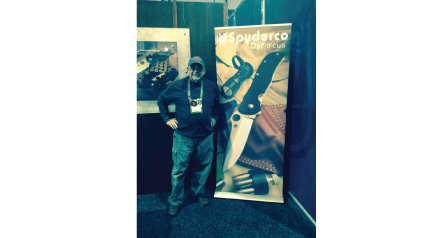
Spyderco Collaborations Terzuola’s first Spyderco design, the C15 Terzuola, was introduced in 1990. It was not only the first Spyderco LinerLock®, it was also the first US-made Spyderco knife and the first to feature a two-position clip. This popular design later inspired a smaller version called the C19 Terzuola Jr., which was introduced in 1994. These designs and Terzuola’s strong desire to have them made in the U.S. were instrumental in the establishment of Spyderco’s Golden, Colorado factory. In 1999, Spyderco released the C55 Starmate. Based on Terzuola’s most popular custom designs, the Century Starfighter and the ATCF, the Starmate was one of the first production knives to be modeled directly on a signature custom design. It became an instant classic and set a precedent for the many custom collaborations now common in the knife industry. The Starmate remained in the Spyderco line for several years before being discontinued. Its popularity with dedicated end users and collectors never waned, however, and prompted the introduction of a revised version in 2012. One of Terzuola’s lesser-known Spyderco designs was the C131 Ball Joint SLIPIT™. Externally, this unique knife displayed the classic lines and styling of a Bob T design. Internally, however, it featured a unique “Ball Joint” non-locking mechanism that used ball bearings inset into integral springs cut from the handle liners to help keep the blade open during use. One of the most interesting variations of Spyderco’s one-hand-opening, non-locking, clip-carry SLIPIT line of knives, it is now a prized collector’s item. The latest addition to the family of Spyderco/Terzuola collaborations is the Double Bevel. Named for its most distinguishing characteristic, this compact LinerLock folder features a unique double-ground blade. Near the heel of the blade (closest to the handle), it is hollow ground and has a full thickness spine for strength. Near the tip, the blade is full-flat ground with a gradual distal taper and a swedge. The point is a Bob Lum-inspired Americanized tanto that, unlike the conventional faceted tip, flows gracefully into the bevels of the flat grind. Offering the best of both worlds—strength and low-friction slicing performance—this unusual grind makes the Double Bevel an amazingly capable pocket-sized cutting tool. Spyderco is incredibly proud of its association with Bob Terzuola and our ability to share his distinctive style and design genius throughout our history. 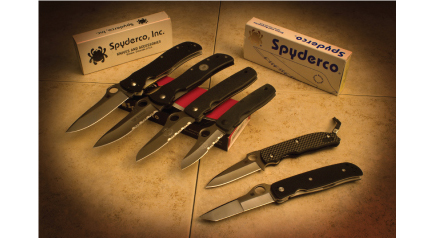
The Concave Ramp - A Bob Terzuola Original Michael Walker’s LinerLock® mechanism revolutionized modern folding knives and was quickly adopted by many savvy custom knifemakers. None, however, have contributed more to the continued evolution of that lock mechanism than Bob Terzuola. A properly made LinerLock must take into consideration a number of critical factors to function reliably. The angle of the tang ramp, the length, thickness, and spring tension of the lock bar, and the angle of the lock bar face must all work in concert to ensure the blade locks securely, while still allowing it to be easily released to close the knife. While most traditional LinerLocks use a flat tang ramp, Terzuola took a different approach. Terzuola took a hard look at the motion of the lock bar and realized that the contact surface at the end of that bar (the lock face) traveled at the end of a radius. Rather than contacting a flat ramp, he believed the lock would work better if the tang ramp was also cut as a radius. Through extensive experimentation and testing, he perfected a method of grinding a concave ramp on the tang of the blade that maximized the galling (the tendency of two contacting metals to “stick” to each other under friction) pressure of the lock bar’s face and the tang ramp. The geometry of Terzuola’s concave ramp also included a small “lip” at the outer edge of the ramp that helps prevent the lock bar from sliding off the ramp under pressure. This is the most common form of lock failure with traditional flat tang ramps. Terzuola’s improved geometry causes the lock bar to snag on the lip, significantly increasing the lock’s strength and dramatically reducing the chances of lock failure. Although this method of LinerLock construction is more costly and time consuming than conventional methods, Spyderco proudly features it on all our Terzuola-designed LinerLock knives. If you’d like to learn more about the details of Bob Terzuola’s approach to LinerLock geometry, as well as his other unique knifemaking methods, he literally “wrote the book” on the topic. That book is his best-selling work The Tactical Folding Knife, which belongs on the shelf of every serious knife enthusiast. 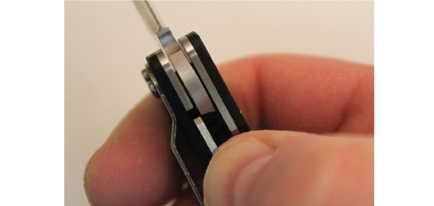
|
||

|
|||

|
EXCLUSIVES Spyderco Exclusives - A Spyderco Exclusive is a run of a special knife model, or other Spyderco product that we manufacture at the request of a wholesale customer. They are typically an existing knife model found in our product line (past or present), but manufactured again using a new/different configuration from what we have previously offered. The differences can be changes to the handle color, different manufacturing materials, blade steels or coatings. How many knives produced is determined by the minimum materials needed to create the model and the number of pieces the customer wishes to order. The owner of an exclusive reserves the right to re-order the knife as long as it is under contract and the owner also determines how it is sold to the retail customer. Spyderco exclusives are a win-win for collectors and many unusual Spyderco knives have resulted from this program. New and upcoming exclusive runs are listed below. Contact the exclusive holder directly if you would like additional information about how to get these rare knives. C172CFBLTIP – Domino Blue Weave Carbon Fiber/Titanium, available in PlainEdge™ by Blue Ridge Knives – www.blueridgeknives.com C122GPGR/C122GPSGR – Tenacious Green G-10 with 8Cr13MoV, available in PlainEdge™ or CombinationEdge™ by Blue Ridge Knives – www.blueridgeknives.com C90GFBLPD – Stretch Blue Nishijin Glass Fiber with Damascus Blade, available in PlainEdge™ by Moteng NA – www.moteng.com C90GBPD – Stretch Black Nishijin Glass Fiber with Damascus Blade, available in PlainEdge™ by Moteng NA – www.moteng.com C41PBN – Native Brown FRN with CTS XHP PlainEdge blade, available in PlainEdge™ by Knife Center – www.knifecenter.com C162PBL – Lil’ Matriarch Blue FRN with VG-10, available in PlainEdge™ by Bento Box Shop – www.bentoboxshop.com C95CFP2 – Manix2XL Carbon Fiber with CPM S90V, available in PlainEdge™ by Knife Works – www.knifeworks.com LPNP3 – Ladybug3 Pink FRN with VG-10 full flat ground blade, available in PlainEdge™ by Cutlery Shoppe - www.cutleryshoppe.com |
||

|
|||

|
AMERICAN FLAG When Spyderco moved to its current location in the late 1990s we gained a number of important benefits. We gained room to locate our manufacturing facility and office space in a single location. We gained the ability to grow the company and add additional employees and products. One thing we didn’t gain was a flag pole. That may seem like an easy addition, but installing a flag pole took a great deal more thought than - well we ever thought. Looking at standard flag poles we realized there is no one-size-fits-all formula for Spyderco. We wanted to share our expression of patriotism and in a big way. With cooperation from the city of Golden we were given permission to install a 60-foot tall pole and a 20 X 30 foot American Flag. Spyderco thanks the crew that oversees the raising and lowering of our flag, and the employees who stay on top of days where we need to lower to half-staff and even repair it when the raging Colorado wind whips it around. Our Appreciation to: Kyle, Andrew, Ben, Rachel, Mike, Christy, Teri, and Pat (official repair seamstress)
|
||

|
   
|
  
|

|
